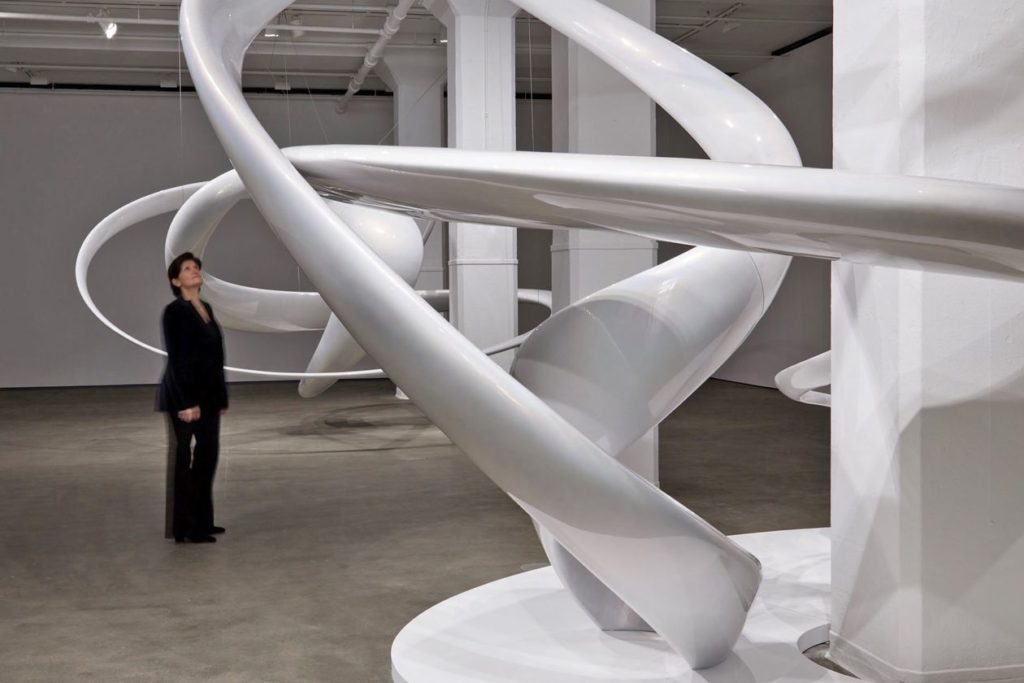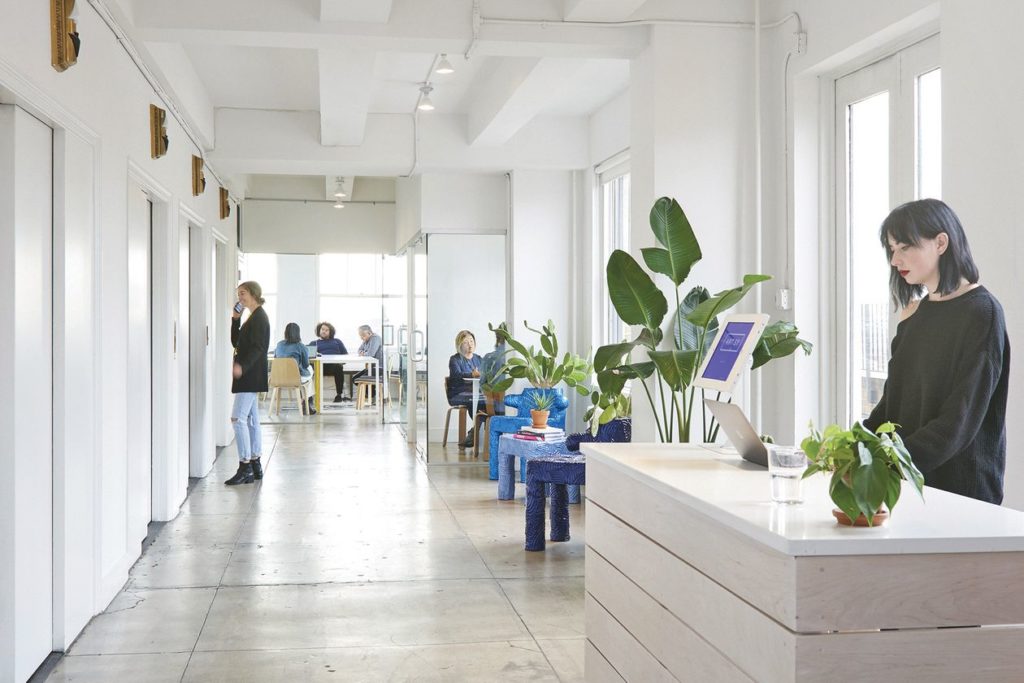Restarting the Art Market

A Mariko Mori sculpture at Sean Kelly Gallery in New York. Kelly has launched a campaign to help demystify the art market.
Photograph by Jason Wyche, New York. Courtesy of Sean Kelly, New York
People who are comfortable buying pricey cars or jewelry often don’t carry the same level of confidence when they step into an art gallery.
“Why?” asks Mike Steib, the CEO of Artsy. His answer: “The industry is opaque, it isn’t accessible, and there’s high transaction friction. So [wealthy people], despite their means, come to believe that it must not be a world that’s available to them.”
Steib is working to make sure Artsy offers a solution to this problem with a platform that allows users to learn about artists, buy art, and bid for works at auction. But his insight reveals what the broader art market is up against.
In 2019, global auction sales at Christie’s, Sotheby’s, and Phillips fell 19.8% from a year earlier, to US$9.74 billion, reports ArtTactic, a London firm that tracks the art market. That’s despite global wealth for those with at least US$1 million stood at a huge US$102.5 trillion at the end of 2018, according to Boston Consulting Group. And that’s before the 31.5% gain in the U.S. Standard & Poor’s 500 index in 2019.
The Deloitte Art & Finance Report 2019 points to these diverging trends as a worrying sign for the global art market. To Anders Petterson, founder of ArtTactic, which co-wrote the report, one explanation for the market’s relative weakness in the face of so much wealth is the opacity of art pricing and information-sharing that Steib noted. “One is a symptom of the other,” Petterson says.
Yet, if changes afoot throughout the art world succeed at disrupting the status quo, the art market has the potential to become more open, inclusive, and accessible for a broader group of collectors.
“We are starting to see pressures coming from many different angles, which I think will force this market to move toward a more professional, more transparent, open marketplace,” Petterson says.
 Artsy’s New York headquarters. Artsy provides a platform for users to learn about artists, and bid on and buy artwork.
Artsy’s New York headquarters. Artsy provides a platform for users to learn about artists, and bid on and buy artwork.
Courtesy of Artsy
A Push for Transparency
Galleries selling primary works by contemporary artists rarely make the prices of the works on their walls easily accessible to someone who walks in off the street. That can be off-putting: Who wants to find out a painting they have fallen in love with is 10 times more than they can afford?
Artsy is one of several players trying to change this by encouraging galleries not only to display their art on Artsy’s mobile app—ideally with prices attached—but also to add what they call a “Buy Now/Make Offer” feature that would allow a collector in Tokyo to buy a work in London with a click. Within the first month of signing on to this platform in the U.K., Archeus/Post-
Modern gallery sold Julie Mehretu’s Untitled, 2006, a watercolor, pen-and-ink on paper work to a California-based collector for US$68,000.
Galleries also are recognizing the power of reaching more potential buyers online. The seven-year-old Denny Dimin Gallery in New York recently launched virtual exhibitions “to bring some of the experience of getting to know the artist and the gallery online,” according to Elizabeth Denny, co-owner, who hopes the site eventually will give visitors an option to buy a work of art too.
Another mystery for novices is how to know the true quality of a work of art, and, in the case of pieces sold on the secondary market, how to have confidence in knowing who owned it in the past. One solution may be with the four-year-old firm Artory, based in New York and Berlin, which is working to provide greater transparency in quality and provenance with a free blockchain-secured art registry backed by the vetting and appraisal services of the global Winston Art Group.
Collectors who register their works on Artory receive a digital key proving ownership in a work of art that is verified by experts. “It’s all about making sure people can start to buy art with reassurance, feeling like they are dealing with credible data,” says Nanne Dekking, co-founder, who is also chairman of The European Art Fair.
Regulators in the U.K. and Europe also are pushing for more transparency of ownership through European Union anti-money laundering directives that went into effect earlier this year. The new rules require auction houses and dealers to ensure they correctly identify buyers for works of €10,000 (US$11,100) or more.
Attracting New Collectors
Auction houses and art fairs, two of the main venues for reaching potential art lovers, also recognize they need to look beyond US$90 million-plus works by David Hockney and Jeff Koons, to find art that is appealing and affordable to a newer generation of collectors.
The auction house Phillips, for instance, began its New Now sales in London and New York in 2015 to provide a mix of works by both younger and established artists, that have a contemporary relevance and are priced roughly between US$3,000 and US$300,000, relatively more affordable than the US$1 million-plus works sold in contemporary evening sales.
“It’s just bringing that material that we know or hope will resonate with younger or first-time buyers as well as more established collectors,” says Sam Mansour, who heads New Now in New York.
Rekindling a Passion For Art
Reaching buyers who haven’t even thought about buying art is on the minds of some art-fair directors.
Nicole Berry, director of The Armory Show in New York, believes fairs provide a nonthreatening atmosphere to ask questions of dealers who want to talk about the art they have on view.
“We’re really interested in expanding people’s understanding of art, whether that’s a veteran collector who might be introduced to a new artist or a new gallery at the fair, or someone who is attending the fair for the first time and is interested in collecting, but is intimidated to walk into a gallery or to begin a conversation,” Berry says.
Sean Kelly, the British owner of a 29-year-old New York gallery, worries about the impact of the large fairs, which he likens to supermarkets where “the food is the same all the time.”
To counteract the preoccupation with “how much something sold for or its perceived abstract value rather than its real value,” Kelly has launched an advertising campaign called Collect Wisely, which features a series of podcasts with collectors young and old.
What has struck Kelly are the similarities between seasoned collectors like J. Tomlinson Hill, a billionaire, and new collectors like Gary Yeh, a first-generation Taiwanese immigrant in his mid-20s, who spends maybe a couple of thousand dollars a year.
“They are passionate about art for the same reasons,” Kelly says. “That to me is incredibly encouraging and gives me massive amounts of optimism for the future.”
